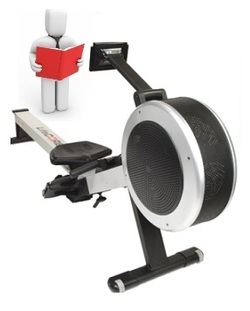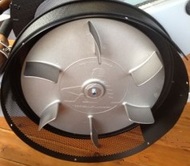So What Does All the Jargon Mean?
 Crack the jargon with our guide
Crack the jargon with our guide
As hard as you try, you just can't avoid all the jargon. Many of the terms used for rowing machines come from conventional rowing on water - no surprise really. Some are relevant to indoor rowing while others have nothing to do with it but have stuck around so they're still used regardless.
Here's our quick guide to the terminology you're likely to come across if you own a rower.
DEAD SPOT - the part of the stroke with a drop in resistance. The better rowing machines do not have a dead spot and you'll feel the tension on the chain through the whole stroke.
DISPLAY - the screen that shows your workout data. For example, how many meters you've rowed, the time it's taken, your strokes per minute, calories used and some will also show your pulse rate. The higher end models have software to download your performance data to your PC.
ERGOMETER - also ergo for short and refers to an indoor rowing machine. The name comes from the early indoor machine used by rowing clubs to measure the performance and technique of their rowers to find the best combination for the positions in a boat.
FEATHERING - action that turns the blade of the oar horizontal - comes after the 'Tap Down' (see below). Both terms refer to rowing on water but many club rowers will use a similar action on an indoor rower.
Here's our quick guide to the terminology you're likely to come across if you own a rower.
DEAD SPOT - the part of the stroke with a drop in resistance. The better rowing machines do not have a dead spot and you'll feel the tension on the chain through the whole stroke.
DISPLAY - the screen that shows your workout data. For example, how many meters you've rowed, the time it's taken, your strokes per minute, calories used and some will also show your pulse rate. The higher end models have software to download your performance data to your PC.
ERGOMETER - also ergo for short and refers to an indoor rowing machine. The name comes from the early indoor machine used by rowing clubs to measure the performance and technique of their rowers to find the best combination for the positions in a boat.
FEATHERING - action that turns the blade of the oar horizontal - comes after the 'Tap Down' (see below). Both terms refer to rowing on water but many club rowers will use a similar action on an indoor rower.
 The flywheel creates the resistance
The flywheel creates the resistance
FLYWHEEL - creates the resistance. It's connected to the chain and spins when you pull back on the Drive part of the stroke (see below). A braking mechanism on the flywheel gives the feeling of an oar moving through water. Can use either air, water or magnets to produce the resistance.
FOLDING MODEL - many machine fold at the end of the rail to allow for storage when not in use. This requires a smaller footprint by placing the rail in the vertical position. If choosing a folding rower check it comes with transport wheels (see below)
FOOTPLATES - not surprisingly it's where you strap in your feet. If your feet are not secured in place you cannot complete the recovery part of the stroke.
HANDLE - also called the BAR, is attached to the chain and replicates the handles of an oar. A good handle should be padded and slightly oval (cross-section) to allow for a good grip. A poorly designed handle can cause blistering on the palm.
HEART RATE MONITOR - can be either a wrist or chest strap, or ear clip to feed your pulse rate to the rowing machine's computer. Note, a chest strap will provide the most accurate reading. This can be used by some rowing machines to tailor your workout to maximize the benefits - see below.
HEART RATE PROGRAMS - use the readout from a heart rate monitor to change the resistance or set target stroke rates to get you into the fat-burning or maximum heart training zones. A big plus in our view and worth paying extra for. See more about this type of training here.
RAIL - the central beam for the seat to roll up and down. This should be sturdy and well supported to prevent the machine moving during a workout. Most rails are made from extruded metal.
RESISTANCE MECHANISM - how the rowing machine creates the resistance. These are hydraulic, air, magnetic or water - see more on these types here. Also see myblog item on air v magnetic.
FOLDING MODEL - many machine fold at the end of the rail to allow for storage when not in use. This requires a smaller footprint by placing the rail in the vertical position. If choosing a folding rower check it comes with transport wheels (see below)
FOOTPLATES - not surprisingly it's where you strap in your feet. If your feet are not secured in place you cannot complete the recovery part of the stroke.
HANDLE - also called the BAR, is attached to the chain and replicates the handles of an oar. A good handle should be padded and slightly oval (cross-section) to allow for a good grip. A poorly designed handle can cause blistering on the palm.
HEART RATE MONITOR - can be either a wrist or chest strap, or ear clip to feed your pulse rate to the rowing machine's computer. Note, a chest strap will provide the most accurate reading. This can be used by some rowing machines to tailor your workout to maximize the benefits - see below.
HEART RATE PROGRAMS - use the readout from a heart rate monitor to change the resistance or set target stroke rates to get you into the fat-burning or maximum heart training zones. A big plus in our view and worth paying extra for. See more about this type of training here.
RAIL - the central beam for the seat to roll up and down. This should be sturdy and well supported to prevent the machine moving during a workout. Most rails are made from extruded metal.
RESISTANCE MECHANISM - how the rowing machine creates the resistance. These are hydraulic, air, magnetic or water - see more on these types here. Also see myblog item on air v magnetic.
|
SEAT - pretty obvious and should be sufficiently padded for comfort - especially if you'll be rowing for 20 minutes or more.
SEAT ROLLERS - the bearings or wheels that allow the seat to slide up and down on the rail. STROKE - one full rowing action comprising of four phases:-
|
|
TABATA WORKOUTS - named after the founder, Izumu Tabata, these workouts (also call Wattage workouts) are based on a target number of watts you can produce based on your body weight. For an example and more information please click here.
TAP DOWN - the action of using the outside of the palm to push down on the oar to take it out of the water. Relates to rowing on open water - also see 'Feathering' above.
TIME TRIALS - Type of workout where you record your time to row a pre-determined distance (usually 2,000 meters), or record your distance rowed within a target time, for example, 2 minutes. The results can be used to judge your progress over time. See here for further details.
TRANSPORT WHEELS - rollers embedded into the feet of a rowing machine that makes it easy to move around and prevents damage to your floor.
WATTAGE WORKOUTS - you may see this on your display. This is the amount of energy you're producing with each stroke. The higher the number, the harder you're working. Also see Tabata workouts above.
You can find more definitions, plus the whole history and development of indoor rowing at Wikipedia/rowing
TAP DOWN - the action of using the outside of the palm to push down on the oar to take it out of the water. Relates to rowing on open water - also see 'Feathering' above.
TIME TRIALS - Type of workout where you record your time to row a pre-determined distance (usually 2,000 meters), or record your distance rowed within a target time, for example, 2 minutes. The results can be used to judge your progress over time. See here for further details.
TRANSPORT WHEELS - rollers embedded into the feet of a rowing machine that makes it easy to move around and prevents damage to your floor.
WATTAGE WORKOUTS - you may see this on your display. This is the amount of energy you're producing with each stroke. The higher the number, the harder you're working. Also see Tabata workouts above.
You can find more definitions, plus the whole history and development of indoor rowing at Wikipedia/rowing